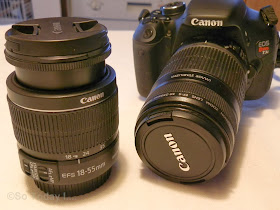 |
| My first camera! |
This aperature business, it was so confusing in the beginning. I understand the concept NOW, after reading it over a million times! The aperature, which plays a vital role in photography by the way, is the size of the opening in the lens when taking a photo and according to how wide or narrow the opening is, determines the amount of light that gets in. Fine, that I understand but when they start saying things like - the bigger the aperture/f-number the smaller the opening which in turn results in a larger depth of field - my mind starts to wander. Then they will go on to mention that large apertures (where lots of light gets through) are given f/stop smaller numbers and smaller apertures (where less light gets through) have larger f-stop numbers. The problem is our brains, (well mine anyways), equate smaller opening to mean a smaller number and not the other way around. So f/2.8 is in fact a much larger aperture than f/22.
So one thing at a time here. Let's just first worry about lighting before tackling depth of field. When it comes to understanding aperature in terms of lighting, just remember this (thanks redbubble.com/):
Higher numbers mean more restriction, and harder to get enough light in and lower numbers mean less restriction therefore lots of light can get in! In other words, Lower = LOTS of light!
Ok, so now that we have THAT out of the way, the next thing to learn is that adjusting the aperature also means adjusting the shutter speed. They go hand-in-hand and if you change one without adjusting the other, you will get something like the picture on the right above. But that's another lesson. For today I'm just learning the basics of aperature and how it changes the depth of field. So the low number which lets lots of light in also means that only part of the image will be in focus and the rest will be fuzzy aka bokeh imagery such as in the example pic I shot below.


